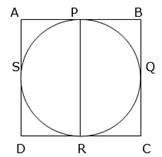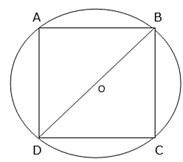The side of a square is 10 cm. Find
(i) The area of the inscribed circle, and
(ii) The area of the circumscribed circle. [Take π = 3.14.]
(i) 
Consider the above figure, Join PR,
Now PR = Diameter of the inscribed circle
Also, PR = BC = 10 cm.
So, PR = 10 cm
![]()
![]()
⇒ r = 5 cm
∴ Area of inscribed circle = πr2 (put value of r in this equation)
⇒ Area of inscribed circle = π(52)
![]()
![]()
⇒ Area of inscribed circle = 78.57 cm2
The area of inscribed circle is 78.57 cm2.
(ii) 
Consider the above figure, O is the centre of circle and ABCD is a square inscribed. Now OB and OD are radii of circle.
Consider ∆DBC right angled at c (as C is a vertex of square)
∴ Apply Pythagoras theorem in triangle DBC
Hypotenuse2 = Perpendicular2 + Base2
In triangle DBC, hypotenuse = DB,
perpendicular = BC and
base = DC
![]()
Put the values of BC and DC i.e. 10 cm
![]()
⟹ BD2 = 200
⟹ BD = √200
⟹ BD = 10√2 cm
Now radius of circle = half of BD
![]()
⟹ r = (10√2)/2
⟹ r = 5√2 cm
Hence Area of circumscribing circle = πr2
⟹ Area of circumscribing circle = 3.14×5√2×5√2
(put π = 3.14 and r = 5√2 cm)
⇒ Area of circumscribing circle = 3.14 × 50
⇒ Area of circumscribing circle = 157 cm2
Area of circumscribing circle is 157 cm2.